Section #9 - Growing opposition to slavery triggers domestic violence and a schism in America’s churches
Chapter 105: The Webster-Ashburton Treaty Resolves A Series Of Disputes With Britain
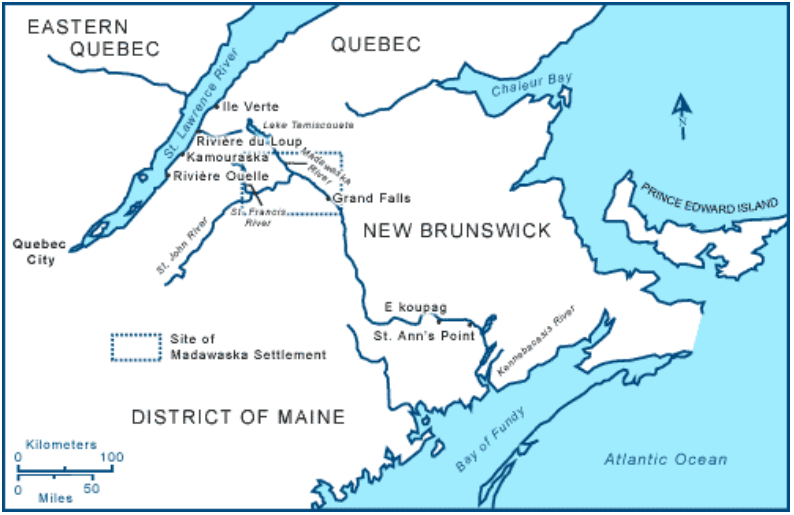
While the Creole incident plays out, negotiations are already under way toward resolving a series of other long-standing disputes between Britain and the United States.
The War of 1812 is a quarter century in the past, but violent confrontations continue to break out, especially along the Canadian border.
In 1837 anti-British protests by farmers in Ontario province lead to a “Republic of Canada” insurgency, which wins support from some Americans living on the Michigan and Ohio borders. In the process of suppressing the rebels, Britain finds that the American steamship Caroline has been carrying arms to the enemy. On December 29, 1837, they assault the ship in port, kill a sailor, torch it, and set it adrift on Lake Niagara heading toward the falls.
The drama of its dying plunge over Niagara Falls is captured in newspaper headlines and lithographs which anger the American public and embed “Remember the Caroline” in the national lexicon. When formal protests to London from Van Buren are ignored, a retaliatory blow is struck in May 1838 as the British steamship Sir Robert Peel is boarded and burned in American waters.
A thornier and more long-standing conflict exists on the east coast.
Its roots go back to the Revolutionary War and the 1783 Treaty of Paris, which fails to spell out the border between Maine and the Maritime province of New Brunswick. The disputed land is rich in timber, and many violent episodes over cutting rights tend to erupt. But for Britain the issue goes beyond commerce to military security – with northern Maine viewed as a roadblock in their direct route from the Atlantic to the crucial citadel at Quebec City.
Tensions rise in 1838 when the British build an east-west road extending across the Aroostook Valley on land claimed by Maine. This leads to a series of clashes between lumber jacks, which escalate into national saber rattling. Congress authorizes a $10 million expense for Van Buren to enlist 50,000 volunteers in 1839 to drive out the intruders, and Britain declares its intent to fight back as needed. But actual fighting is avoided when Van Buren realizes that U.S. financial problems are already severe enough without adding on a costly war. So ends the so-called “Aroostook War,” with a whimper, not a bang.
In 1840 the two sides are back at it over a post-script to the Caroline affair. A Canadian sheriff, Alexander McLeod, who brags about his role in the event, is arrested in New York state and charged with “murdering the sailor” during the raid. When the British learn of the arrest, they threaten war unless McLeod is released, up to the time the trial ends in an acquittal. Between the Creole decision in Nassau, the Caroline incident, the Aroostook “war,” and the McLeod arrest, it becomes clear to the leaders of both nations that the time has come for peace talks.
August 9, 1842
The Webster-Ashburton Treaty Resolves The Conflicts
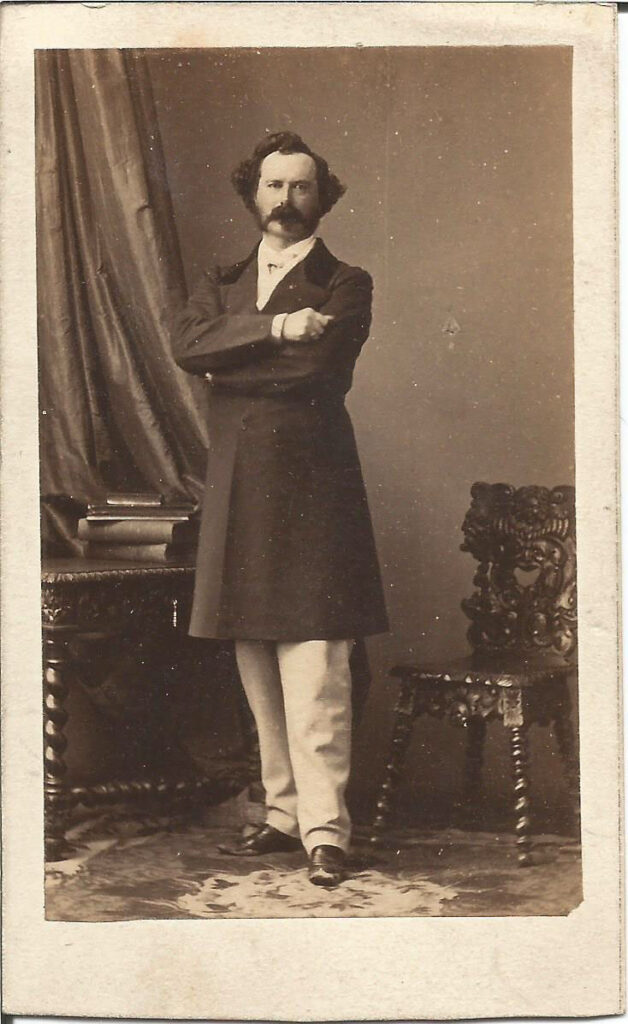
The search for resolution is apparently initiated by Sir Robert Peel, a Tory, who begins his second stint as Prime Minister in August 1841, in the fourth year of Queen Victoria’s 63 year reign.
Peel selects the formidable Alexander Baring, 1st Baron Ashburton, to negotiate with the Americans. He is the 67 year old retired Chairman of Baring Brothers & Co, the international merchant banking firm founded by his father in 1762. The firm’s relations with the United States go way back in time, including a central role in closing the 1803 Louisiana Purchase deal. Ashburton’s wife is a Philadelphia native, and he owns roughly one million acres (1500 square miles) of land in the contested region of Maine, so he is personally motivated to find a border resolution.
Ashburton is also a long-term associate of Secretary of State, Daniel Webster, having hired him to handle various legal matters for Baring Brothers in U.S. courts. In turn, Webster is a lifetime Anglophile, who has been a house guest of Ashburton’s on visits to London.
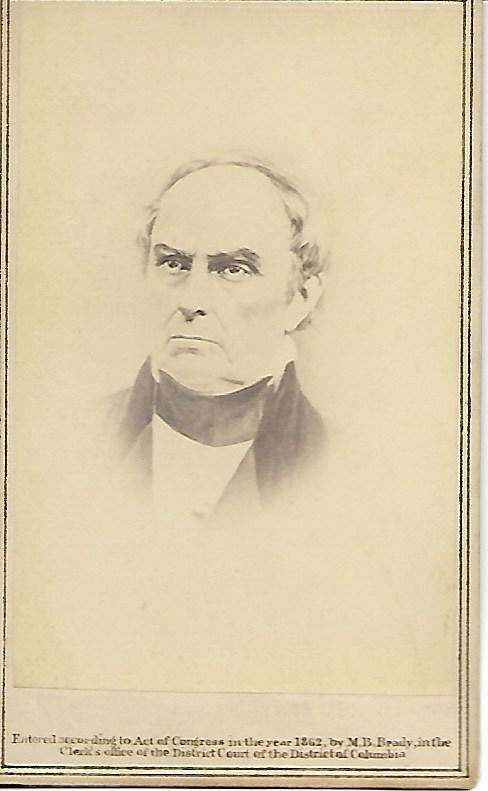
Ashburton arrives in April 1842 and meets with Webster and Tyler, whom he regards as “conceited and weak,” until the President wins him over with his hospitality. The two Americans need the negotiations to work out every bit as much as their guest, given their politically embattled status with the Clay-dominated Congress.
The talks focus on the central bone of contention, the borderline between Maine and New Brunswick. Maps and records from the 1783 Treaty of Paris are resurrected in advance by Harvard historian Jared Sparks, who unfortunately concludes that the boundary proposed by the British is probably correct. Still, Webster intends to rely on his negotiating talents and relationship with Ashburton to achieve a more attractive outcome.
The British are not, however, the only ones who need to be won over. Fierce resistance to any compromise exists in northern Maine, and a secret government “contingency fund” is spent on a propaganda campaign to gin up state support. Some consider this expenditure an impeachable offense, but a later inquiry turns this aside.
The two parties remain at an impasse until Tyler meets personally with Ashburton, pleading that “if you cannot settle (the dispute), what man in England can?” This appeal leads to a final agreement reached on August 9, 1842.
The deal addresses four issues.
First and foremost, is the creation of a new compromise map for the Maine-New Brunswick border. In the deal, British Canada ends up with 5,000 square miles to the north, which satisfies their wish for a more direct passageway in the 650 mile trek from Halifax to Quebec. In return the U.S. gets 7,000 square miles below the British line in Maine, along with 6,500 square miles of land out west in northern Minnesota – the “Mesabi Range,” where vast deposits of iron ore are discovered in 1866.
Those easterners who dismiss the value of the British concession out west are soothed by $125,000 payments made by Washington to the states of Maine and Massachusetts (the latter at one time having included all of Maine in its boundary).
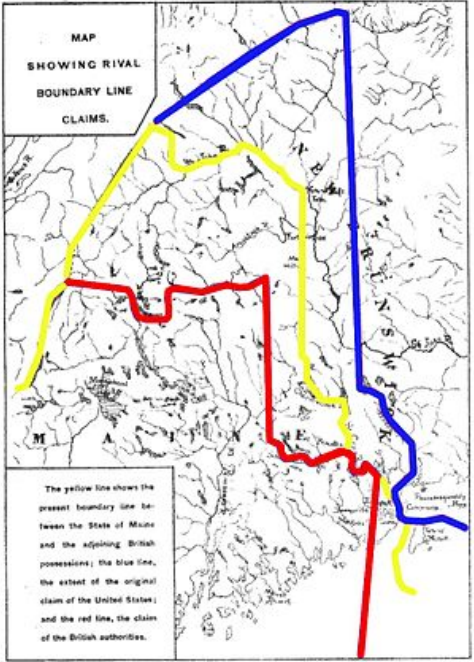
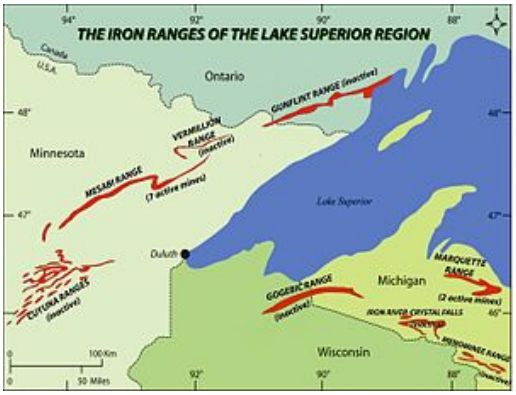
The U.S. Blue = US proposal; Yellow = Final Compromise.
When Webster raises the Creole affair, Ashburton initially dodges, saying that he lacks authority on the matter since the Nassau rulings transpired while he was in route to the States. When pushed, however, he reaffirms the British position that any slave reaching UK commonwealth soil will automatically be declared free. This principle – a slave reaching free territory is freed – is precisely what the South fears most, if applied domestically. So Webster persists, earning two concessions in the end: British officials in the West Indies will be instructed to avoid such incidents in the future when possible; and a commission will be set up to discuss compensation (which is later granted to the tune of $100,000) for owners of the Creole slaves.
Ashburton is even less sympathetic when the torching of the Caroline is discussed. The message to America is stay out of future internal affairs in Canada, or else. For general face saving purposes the words “regrets” is floated out to the public.
Finally, Tyler proposes and Ashburton accepts a revised plan whereby US and UK ships at sea would avoid future boardings in search of international slave cargoes.
With the four frictions apparently resolved, the negotiators shake hands on August 9.
Webster anticipates resistance to several aspects of the treaty within the Senate, and two Democrats in particular – Thomas Hart Benson of Missouri and James Buchanan of Pennsylvania – attack it. But John C. Calhoun supports the deal as does Tyler’s nemesis in Virginia politics, William Rives, Chairman of the Foreign Relations Committee.
On August 20, 1842 the Senate approves the Treaty by a vote of 39-9 – marking the one significant accomplishment that Tyler will achieve in foreign policy during his tenure.